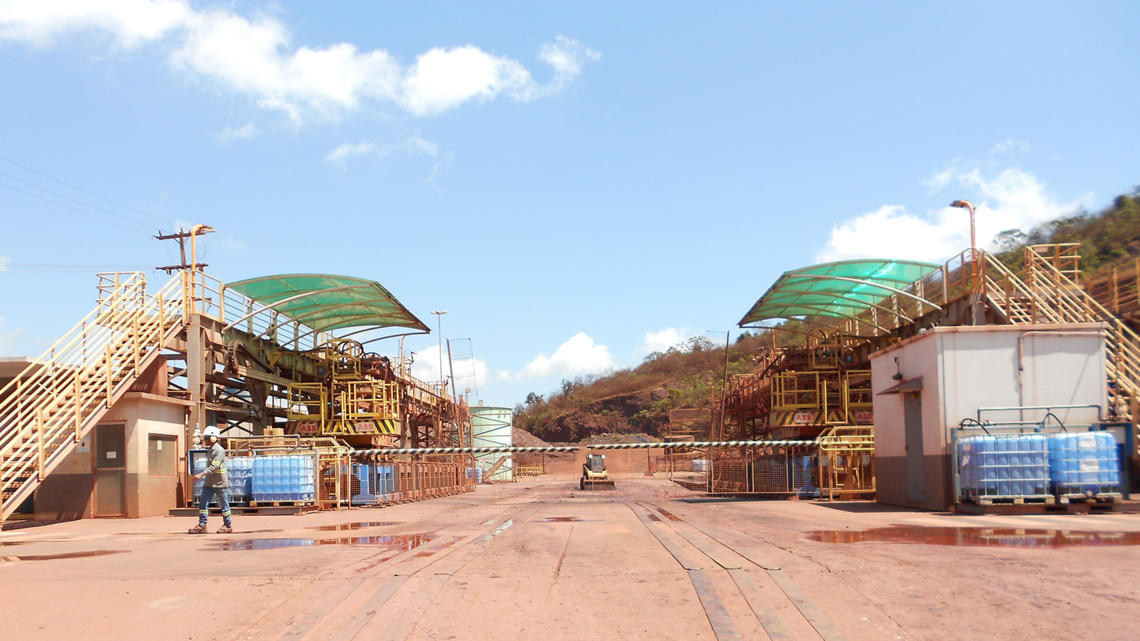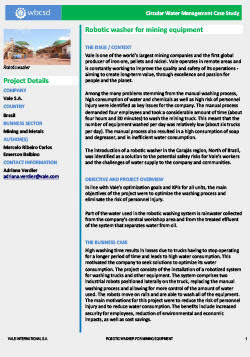The issue / context
Vale is one of the world’s largest mining companies and the first global producer of iron ore, pellets and nickel. Vale operates in remote areas and is constantly working to improve the quality and safety of its operations -aiming to create long-term value, through excellence and passion for people and the planet.
Among the many problems stemming from the manual washing process, high consumption of water and chemicals as well as high risk of personnel injury were identified as key issues for the company. The manual process demanded four employees and took a considerable amount of time (about four hours and 30 minutes) to wash the mining truck. This meant that the number of equipment washed per day was relatively low (about six trucks per day). The manual process also resulted in a high consumption of soap and degreaser, and in inefficient water consumption.
The introduction of a robotic washer in the Carajás region, North of Brazil, was identified as a solution to the potential safety risks for Vale’s workers and the challenges of water supply to the company and communities.
Objective and project overview
In line with Vale’s optimization goals and KPIs for all units, the main objectives of the project were to optimize the washing process and eliminate the risk of personnel injury.
Part of the water used in the robotic washing system is rainwater collected from the company’s central workshop area and from the treated effluent of the system that separates water from oil.
The business case
High washing time results in losses due to trucks having to stop operating for a longer period of time and leads to high water consumption. This motivated the company to seek solutions to optimize its water consumption. The project consists of the installation of a robotized system for washing trucks and other equipment. The system comprises two industrial robots positioned laterally on the truck, replacing the manual washing process and allowing for more control of the amount of water used. The robots move on rails and are able to wash all of the equipment. The main motivations for this project were to reduce the risk of personnel injury and to reduce water consumption. The benefits include increased security for employees, reduction of environmental and economic impacts, as well as cost savings.
Decision making process
The Departments of iron ore and Planning and Development of the location’s Engineering and Process Automation areas were involved in the decision making process.
Project details & finances
Evaluation of the project's financial gains considered the following factors:
- FTE required for operation;
- Average time of washing;
- Consumption and cost of supplies (soap, degreaser, water, etc.)
Based on this information, it was possible to see a reduction in costs of approximately 60%.
Project results
The initiative has increased the safety of the process and reduced washing time by 50%. It also has enabled 80% water reuse (based on Vale’s historical data and estimations).
Overall, the project led to cost savings of 623.000 R$ per year (approximately USD$ 200,000) while reducing the company’s impact on the environment.
More specifically, the project led to the following positive outcomes:
- Reduction in washing time (from 4.5 hour per truck to 1.7 hour per truck)
- Reduction in water consumption: 36,793 m3 / year
- Reduction in use of chemicals due to dosage control, shorter washing time and reduction in water use
- Reduction of risk to personnel injury due to removal of human interactions with the trucks
Predicted |
Actual |
|
Return on investment |
N/A |
24% |
Annual savings (USD$) |
N/A |
Approx. 200,000 (The economic evaluations of this project were carried out between 2008 and 2010) |
Annual water savings |
N/A |
36,793 m3 /year |
Annual energy savings (if tracked) |
N/A |
N/A |
The capital expenditure was 5.2 million Reais (approximately USD$ 1.6 million) to implement the automatic washer. The internal rate of return was 18% and the payback period was around 5 years.
The robotic system reduced the washing time to fewer than two hours, and about 80% of the water is reused in the process to wash the next equipment. Therefore, trucks go back to operations sooner than when the process was manual; this represents a gain of more than 900 tons daily in the production of iron ore. Per month, this represents more than 200,000 tons of iron ore, considering the daily average of six trucks washed. The cost of the total investment was 1 million Reais (approximately USD$ 313,500) which is reduced to 388,000 Reais (approximately USD$ 121,600) after deducting the gain in production mentioned above.
Lessons learned
Main key lessons learned have been:
- An operational improvement can sometimes lead to significant cost savings while helping the environment and improving the health and safety of employees
- Given the company uses less water to wash the equipment, it also uses less chemicals which results in wastewater treatment cost savings.
Future implementation and next steps
There are studies for replicating this technology in other operations that use large trucks and where the washing process represents a bottleneck for the maintenance process. The issue of new water collection is also considered.
Download case study
References
- Watch Lavador Robotizado (Baixa) video
- http://www.revistaminerios.com.br/EdicoesInt/1639/39/100_marcas_promovem_tecnologias_de_ponta.aspx
This case study forms part of the WBCSD Business Guide to Circular Water Management (2017), available for download here.
Project detailsCompany: Vale S.A Country: Brazil Business sector: Mining and Metals Author(s): Marcelo Ribeiro Carlos, Emerson Balbino Contact information: Adriana Verdier (adriana.verdier@vale.com) |


